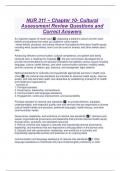NUR 311 ~ Chapter 10- Cultural
Assessment Review Questions and
Correct Answers
An important aspect of health care ✅- assessing a patient's culture and the many
beliefs and practices that make up a patient's value system
- these beliefs, practices, and values influence how patients think about health issues,
including what causes illness, how it can be cured or treated, and other beliefs about
care
Advancing effective communication, cultural competence, and patient and family
centered care: a roadmap for hospitals ✅- the joint commission developed this to
provide recommendations and practice examples that address various issues including
language, culture, health literacy, and other communication barriers; mobility needs;
and the concerns of lesbian, gay, bisexual, and transgender (lgbt) patients
National standards for culturally and linguistically appropriate services in health care
(clas) ✅- the national clas standards are intended to advance health equity, improve
quality, and help eliminate health care disparities by establishing a blueprint for health
and healthcare organizations
- consists of:
1. Principal standard
2. Governance, leadership, and workforce
3. Communication and language assistance
4. Engagement, continuous improvement, and accountability
Principal standard of national clas standards ✅- to provide effective, equitable,
understandable, and respectful quality care and services that are responsive to diverse
cultural health beliefs and practices, preferred languages, health literacy, and other
communication needs
Governance, leadership, and workforce of national clas standards ✅1. Advance and
sustain organizational governance and leadership that promote clas and health equity
through policy, practices, and allocated resources
2. Recruit, promote and support a culturally and linguistically diverse governance,
leadership, and workforce that are responsive to the population in the service area
3. Educate and train governance, leadership, and workforce in culturally and
linguistically appropriate policies and practices on an ongoing basis
Communication and language assistance of national clas standards ✅1. Offer
language assistance to individuals who have limited english proficiency or other
, communication needs at no cost to them, to facilitate timely access to all health care
and services
2. Inform all individuals of the availability of language assistance services clearly and in
their preferred language, verbally and in writing
3. Ensure the competence of individuals providing language assistance, recognizing
that the use of untrained individuals or minors as interpreters should be avoided
4. Provide easy-to-understand print and multimedia materials and signage in the
languages commonly used by populations in the service area
Engagement, continuous improvement, and accountability of national clas standards
✅1. Establish culturally and linguistically appropriate goals, policies, and management
accountability, and infuse them throughout the organization's planning and operations
2. Conduct ongoing assessments of the organization's clas-related activities and
integrate clas-related measures into measurement and continuous quality improvement
activities
3. Collect and maintain quality and reliable demographic data to monitor and evaluate
the impact of clas on health equity and outcomes and to inform service delivery
4. Conduct regular assessments of community health assets and needs and use the
results to plan and implement services that respond to the cultural and linguistic
diversity of populations in the service area
5. Partner with the community to design, implement, and evaluate policies, practices,
and services to ensure cultural and linguistic appropriateness
6. Create conflict and grievance resolution processes that are culturally and linguistically
appropriate to identify, prevent, and resolve conflicts or complaints
7. Communicate the organization's progress in implementing and sustaining clas to all
stakeholders, constituents, and the general public
Characteristics of culture ✅1. Nationality
2. Race
3. Skin color
4. Gender
5. Age
6. Religious affiliation
7. Educational status
8. Occupation
9. Military experience
10. Political beliefs
11. Urban versus rural residence
12. Enclave identity
13. Marital status
14. Physical characteristics
15. Sexual orientation
16. Gender issues
17. Length of time away from country of origin
18. Reason for migration




